
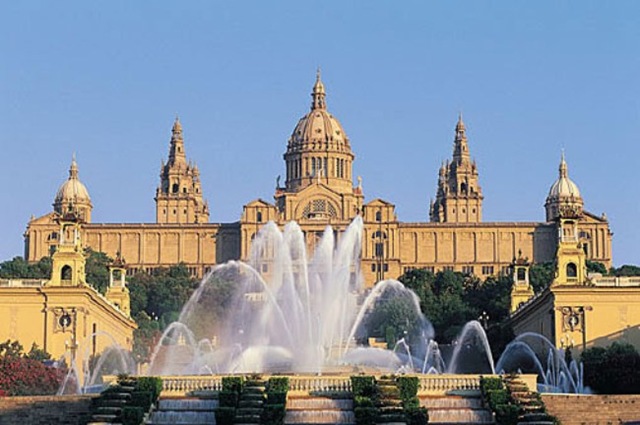
Area - about 505 000 km2.
Population - more than 40 million people.
Capital - Madrid (4 million inhabitants).
Official language - Spanish.
Religion - Catholicism.
Currency - the euro.
Spain - a country with an ancient history. In ancient times, in Spain the tribes of Iberians, Celts they were later replaced. In the third century BC, much of the country was ruled by the militant Carthage, and by the end of the 1st century BC. e. became part of the Roman Empire. State of the Visigoths (from 2nd floor. 5. BC. E.) Eliminated Arabs who invaded in 711-718 nearly all of Spain and created a number of states. During the Reconquista (718-1492) emerged the Spanish kingdom of Aragon, Castile, etc. Since the dynastic union of Castile and Aragon in 1479 Spain - one state. In the 16th century established absolutism. In Spain survived numerous remains of ancient Greek, Carthaginian and Roman settlements. About eight centuries almost all the Iberian Peninsula was under the rule of the Arabs. Arab era has left a deep mark in language, culture, architecture, and in the economy.
Climate in Spain
More than half of the country is the vast elevated plateau, which
crosses across the five major mountain ranges of the country. In fact,
with an average height of 650 m above sea level - the highest country in
Europe after Switzerland. Has a positive impact on the climate of Spain.
Landscapes are replaced from the Andalusian desert, green wetlands of
Galicia, then follow the hot plains of Castilla-La Mancha and end stormy
and snowy peak of Europe, and finally - the Pyrenees.
Traditions of Spain
Spain - a guitar, flamenco, bullfighting! That is the chain of
associations builds our mind when we talk about the bright and wonderful
country.
Perhaps a few of its European neighbors can compete with the Spaniards
in such reverent preservation and augmentation of traditions born in
this "European cultural cauldron" where coexist and Moorish elegance,
and Gypsy passion, depth and Celtic and Romanesque splendor.
The famous Spanish poet and writer Federico Garcia Lorca called flamenco
most magnificent achievement of the Spanish people. This fusion of
melody, rhythm and movement created the very soul of the Spaniard. A
material has an incredible mix of European and Asian cultures have left
their mark, the pain and the blood, and their musical traditions in the
beautiful land of Spain. Guitar, an indispensable participant flamenco
shows, was born in Andalusia, and since then makes the march around the
world. Dozens of guitar music festivals taking place in Spain itself.
Get the full picture of flamenco festivals can "cante jondo", taking
place in June and October in the main squares of small towns. Apogee
flamenco season - a holiday "De Buleryas" in Jerez de la Frontera,
"Biennale art of flamenco" in Seville, taking place in September. In
almost all cities in Spain there is a cafe and restaurants, where you
can see the fiery flamenco show.
Besides the famous flamenco in Spain, there are about a thousand dances.
Jota Aragonese, melancholic alala, who came from Galicia, muneyra,
followed astriyskimi bagpipes, Catalan Sardana - a few of the
traditional dances of the peoples of Spain, is still performed on
weekends and holidays in the squares of cities and small towns.
Art "tavromahii" corrida-few people can remain indifferent. Fight human
and natural disaster - causes and enthusiasm, and fierce condemnation.
Having been born in the time of the Iberians, bullfights in medieval
Spain is the favorite national spectacle that accompanies all important
holidays. Bullfighting banned kings and the Pope, its sung by Lope de
Vega, Tirso de Molina, her fans were great Goya, Merimee and Hemingway.
Today, many opponents of bullfighting, considering this show barbarism
and savage relic of medieval society. However, according to all the
opinion polls for the main holiday themselves Spaniards call celebration
of bullfighting. The famous San Fermin festival in Pamplona every year
attracts thousands of thrill-seekers from around the world to become a
member of the famous races with the bulls.
Attractions in Spain
Castles of Castile
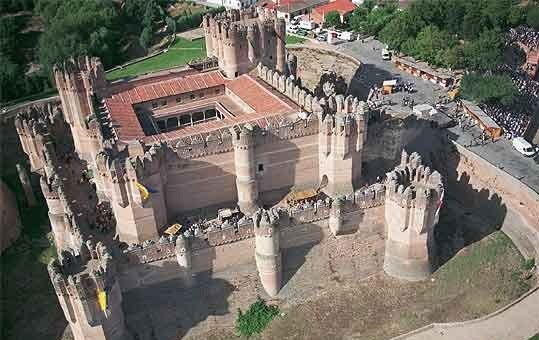
The very name of the region, Castile, means "castle", originally "Castile" is called a neighborhood of Burgos. Indeed, in the lands of the Castilian provinces is a lot of locks. In the XI-XII centuries., When the central part of Spain was a place of constant battles, castles were built and the Moors and the Christians, and their often besieged, destroyed, rebuilt again - not by chance, many castles, fortresses are Arabic names "Alcazaba", "Alcazar" (" Fortress "). However, after the release of Castile from the Moors process of building new locks did not stop - the Spanish aristocrats built their residences are not as palaces, namely as fortified castles: the constant internecine struggle demanded protection. Therefore, every lock any related episodes in Spanish history, legends and myths. Only at the end of the XV century. Ferdinand and Isabella issued a decree banning the construction of new locks. Typical Castilian castle stands on a hill or mountain, surrounded by thick walls with battlements and machicolations (machicolation) and surrounded by a moat over which hung a drawbridge. From the walls of the castle defenders pouring boiling water on the enemy and butter, throwing stones, were fired. In the center of the fenced area was a tall tower (donjon) - with her were monitored and it is usually located apartments lord and his family. Also in the castle there were all the necessary ancillary services - stables, warehouses, kitchens, etc. In a big castle territory was divided into two parts: one lived artisans in the other - seniors and soldiers. Now some locks transferred podoteli-parador, others still live Spanish aristocrats, some places are open museums, schools, but most castles abandoned.
Salamanca
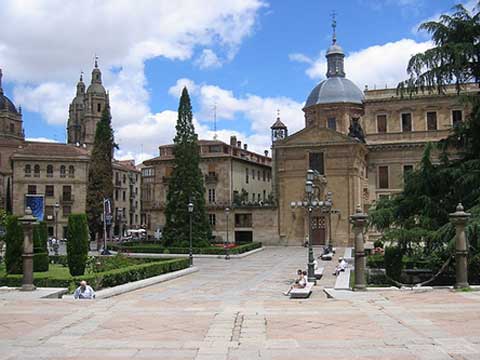
Salamanca, a magnificent
Renaissance and university city, is on the banks of the River Tormes.
Old quarters, where the university, ancient churches and monasteries are
located on the north bank of the river, as the major stations. The old
town center - Sq. Major, a little closer to the river there are two
cathedrals. Advised to come to the city no less than a day, and if you
want to carefully inspect the museums and monasteries of Salamanca, and
then for two days.
Introduction to the Salamanca easier to start from the oldest buildings
in the city - the Roman bridge over the River Tormes. In 1626 a flood
destroyed most of the bridge, so to have survived only 15 original Roman
arches I to. (from the center) and the rest were built in the XVII
century. The bridge offers stunning views of the city and most of its
buildings are built of local sandstone, which has pale golden color,
which gives the Salamanca (especially on sunny days), unusual flavor.
Casually in Spanish literature Salamanca often referred to as "golden".
Old town of Santiago de Compostela
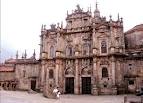
The end-point of one of the most important ways of pilgrimage for Christians was and is the city of Santiago de Compostela in Galicia in the north-western tip of the Iberian Peninsula. In 813 g there was found buried St. James, and for the past many centuries, tens of thousands of people flock to Santiago from France through the Pyrenees on pilgrimage route of Saint. Jacob. The city is rich in sacred buildings. This Romanesque cathedral, the facade of which relates to the XVIII century. and in style Churrigueresque, the Spanish version of the Baroque. In addition to the other 40 churches should be called the Archbishop's Palace, the Royal Hospital (1511) and the monastery of San Martín Pinar. Old Town, in 1985, included in the UNESCO World Heritage List.
Cities in Spain
Barcelona
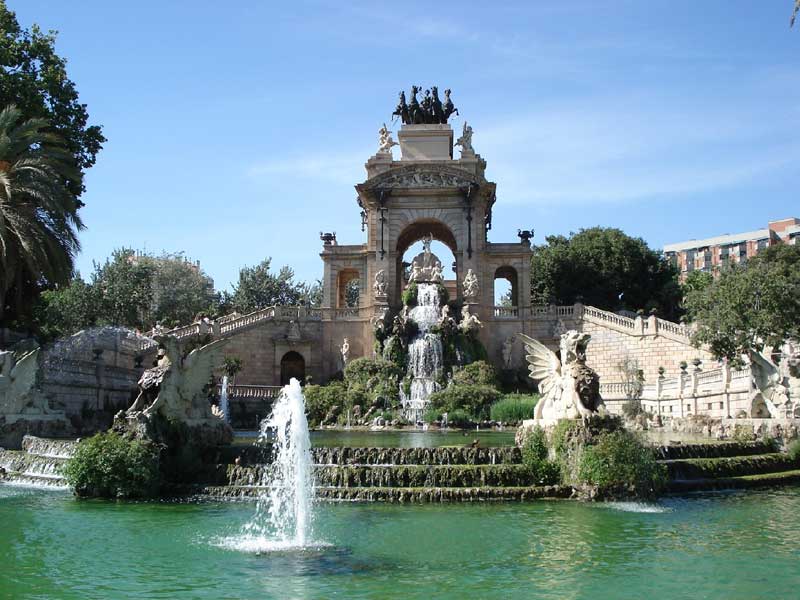 Barcelona - Spain's main tourist
attraction and the second largest city in the Iberian country. Barcelona
is located on the north-east of the country, 120 km from the
Spanish-French border and is the capital of the autonomous province of
Catalonia - the most important from an economic point of view, the
region of Spain. The city is an important industrial and commercial
center, not only in Spain but throughout Europe. The port of Barcelona
is among the ten busiest ports in Europe, and the airport El Prat - the
largest among all the airports situated on the Mediterranean Sea. That,
however, is not surprising, since Barcelona is just the largest and most
populous city of the Mediterranean.
Barcelona - Spain's main tourist
attraction and the second largest city in the Iberian country. Barcelona
is located on the north-east of the country, 120 km from the
Spanish-French border and is the capital of the autonomous province of
Catalonia - the most important from an economic point of view, the
region of Spain. The city is an important industrial and commercial
center, not only in Spain but throughout Europe. The port of Barcelona
is among the ten busiest ports in Europe, and the airport El Prat - the
largest among all the airports situated on the Mediterranean Sea. That,
however, is not surprising, since Barcelona is just the largest and most
populous city of the Mediterranean.
The population of the city proper Barcelona is 1,621,537 people (2009),
but Barcelona is not completed only part of the city. In the Barcelona
metropolitan area, the so-called Great Barcelona, in an area of 636
square meters. 3,218,071 kilometers living people (2009). Thus he
metropolitan area is part of the Catalan province of Barcelona, where
the population reaches 5,012,961 inhabitants (2010). All this makes
Barcelona the sixth largest metropolitan area in Europe and the largest
on the Mediterranean coast.
Geographically, the city is on the coastal plateau area of 170 square
meters. kilometers, of which 101 square meters. kilometer is the city
itself. From the south-west is a plateau bounded by mountains and the
river Llobregat Kolserola, and from the north - the river Besòs. Due to
the mountains the city has a unique landscape, and the highest point is
Mount Tibidabo Barcelona height of 512 meters, which is the so-called
Tower Kolserola - TV tower 288.4 meters, designed by Sir Norman Foster
for the Olympics in 1992 and visible from most parts of the city.
Like many coastal cities, Barcelona is located on several hills, whose
names were later called urban neighborhoods: Carmel (Carmel, 267 m),
Monterols (Monterols, 121 m), Puchet (Putxet, 181 m) and Rovira (Rovira,
261 m) and Peyrat (Peira, 133 m). Little known and love tourists is the
mountain of Montjuic height of 173 meters, in the south-west of
Barcelona. At Montjuic are many attraction
Valladolid
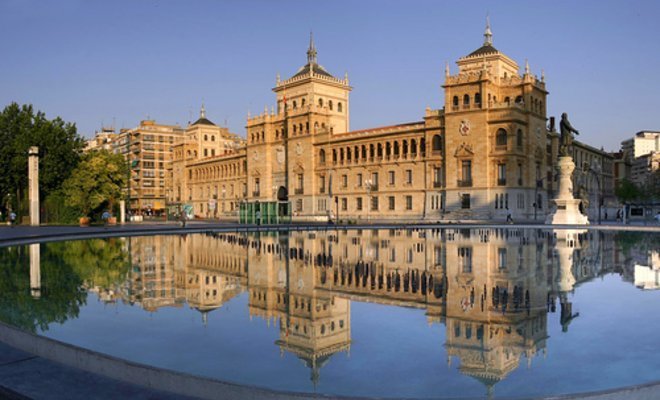 Valladolid
is the capital of the Spanish autonomous Castile and Leon. The city is
also the center of the homonymous province to him. In the Middle Ages
was one of Valladolid of the Spanish capital.
Valladolid
is the capital of the Spanish autonomous Castile and Leon. The city is
also the center of the homonymous province to him. In the Middle Ages
was one of Valladolid of the Spanish capital.
Valladolid was founded by the Romans, as evidenced in this city found
Roman mosaics. However, in Roman times Valladolid was a little
settlement. Valladolid was a real city in the Middle Ages.
The city is famous, above all, the fact that it happened in 1489, the
marriage of Isabella of Castile and Ferdinand of Aragon, what was the
beginning of unification of Spain.
In the early 13th century, during the reign of King Alfonso the Eighth
Valladolid first became the capital of the Spanish kingdom. Next King of
Spain granted the city certain trade privileges, so that Valladolid has
become one of the richest cities in Spain.
In the early 14th century Queen of Spain Maria de Molina chose
Valladolid as their main residence. At the same time the Queen has
realigned Arabic Alcazar in one of the most magnificent palaces in
Europe. In 1346, at Valladolid University was opened.
The city was also born King Philip II, while Cervantes lived and worked,
and ended his days in poverty and oblivion the great explorer
Christopher Columbus.
Valladolid is famous for its historical center, in the old buildings
which are all government autonomy. The main attractions are the
Cathedral, surrounded by beautiful gardens, and a board of Santa Cruz
and Santa Gregory College. Another attraction of Valladolid - a museum
of sculpture, which is the largest such museum in Spain. In his
exposition can see sculpture of 16-17 centuries, including works by
famous masters Berruguete.
However, the main square of the city - is the Plaza Mayor. This area was
built in the days when Valladolid was the capital of Spain, and
therefore an object in the years to follow many Spanish cities.
The best time to visit the city - Holy Week, the celebration is annually
visited by millions of tourists Valladolid. In the neighborhood you can
also see a lot of castles and chateaux.
Sevilla
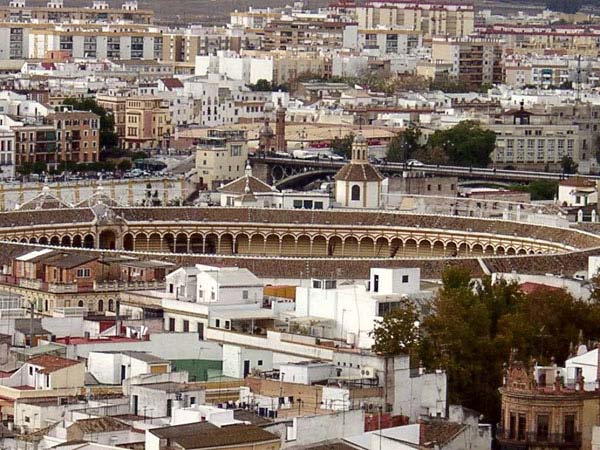 Seville
- the fourth largest city in the south of Spain, with a population of
700,000 inhabitants, the center of the autonomy of Andalusia. Based, as
they say, the Greek hero Heracles.
Seville
- the fourth largest city in the south of Spain, with a population of
700,000 inhabitants, the center of the autonomy of Andalusia. Based, as
they say, the Greek hero Heracles.
Walk around the city and look at the sights and see the invisible
tourist Seville.
The city has a luxurious logo - check out the cool work of the designer
of the Renaissance. Seville logo - is a rebus, which contains the
phrase, belonging to King Alfonso X the Wise. King dethroned by his own
son, and the exiled monarch could not find a shelter anywhere except in
Seville, which adopted it.
Finding shelter and rest, grateful Spanish king said of Seville, "She
has not left me." In Spanish, it sounds: No (madeja) do = No me ha
dejado (But madeha to) the word "madeha" - a coil of rope, a skein of
wool. So designer graphically depicted word in the phrase exiled monarch
and it became a symbol of the city. He can be seen everywhere: on buses,
posters, booklets, even on manholes. This is a great find of the artist
remained unknown to us through the ages. I envy and admire:
It looked like center of Seville in 1926. In the picture the cathedral,
called Santa Maria de la Sede. It was built on the site of the mosque
1172-1248 gg. Minaret of the mosque was left, which turned into a bell
tower and a courtyard with orange trees. In the XVI century, the
Spaniards began to build a cathedral and Christian bishops said, "Let's
make the church such a beautiful and ambitious, so that everyone who
sees it, thought that we were crazy." In 1506, the cathedral was built.
I do not think anyone thought he was crazy creators, because from the
outside, especially in the Santa Maria de la Sede is an awesome
experience. I knowingly say that Notre Dame de Paris, Paris or Cologne
Cathedral Basilica of the Sacre Coeur are very inferior to the
impression that this man produces for the temple of God:
Moors, who built the mosque, used improvised material remaining to them
from the Romans - is now at the base of the minaret-bell tower can be
seen here are the remains of Roman civilization existed here since 2
v.d.e.